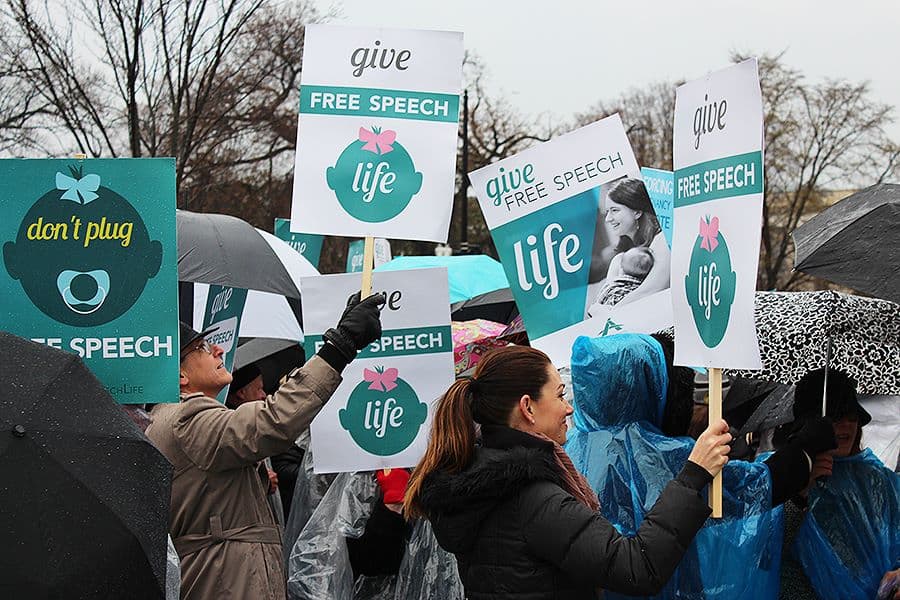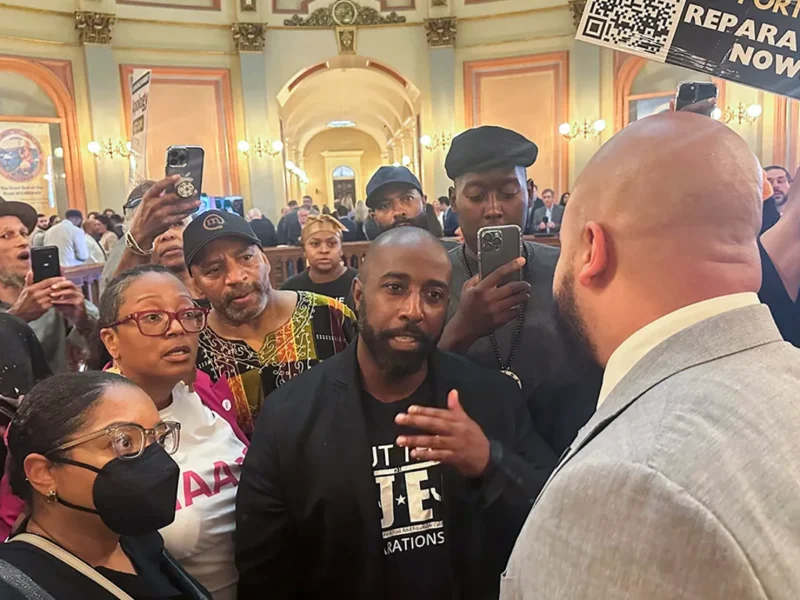NIFLA v. Becerra, It’s Not an Abortion Case
The Reproductive FACT act was a boldly unconstitutional law that was signed by Governor Brown in October 2015.
The Bill, AB 775 (Later codified as H&S 123470) was entitled the Reproductive FACT Act (Freedom, Accountability, Comprehensive Care, and Accountability) The bill provided that Pro-Life Pregnancy centers, who exist because of their objection to abortion, would be required to provide information about abortion to their clients, in their office, on their internal forms and in all advertising. The onerous law also mandated exact language, required large font type and required in some counties that the notices would have to be provided in 13 languages.
The case (NIFLA v. Becerra) decided by the Supreme Court was an appeal brought by NIFLA (National Institute for Life and Family Advocates) after the Ninth Circuit ruled the law to be constitutional and not in violation of the First Amendment. There was another case brought in Riverside County Superior court, Sharpen v. Harris, challenging the constitutionality of the law. Judge Gloria Trask ruled in favor of the pregnancy center, finding that the FACT Act violated Article 1, section 2 of the California Constitution.
The Riverside Superior court relied upon U.S. Supreme Court precedent related to the U.S. constitution’s First Amendment. The court stated, “Compelled speech is that which forces a speaker to say that which he or she may or may not believe. Compelled speech is undoubtedly necessary in many circumstances. But compelled speech of a political or cultural nature, is not the tool of a free government.”
The Riverside court applied Strict Scrutiny, the highest level of constitutional scrutiny, and said that the political speech related to abortion, can not be neutral in nature. The court found that the state of California failed to show any compelling state interest advanced by the regulation.
The FACT Act mandated two different notices. One notice was for ‘licensed’ facilities, and another notice for ‘unlicensed’ facilities. A ‘licensed’ facility was defined by the statute as a clinic whose ‘primary purpose is providing family planning or pregnancy related services’. The ‘unlicensed’ facility was defined as one ‘whose primary purpose is pregnancy related services’ but who did not have a medical director on staff.
The Ninth Circuit said that the pregnancy centers “were unable to demonstrate a likelihood of success on the merits of their First Amendment claims.” The Ninth Circuit court went on to state that Strict Scrutiny was not warranted and that the “Act is a neutral law of general applicability, which survived rational basis (The lowest level of constitutional scrutiny) review.” As to the notice for licensed facilities, the Ninth Circuit found that it was entitled to only Intermediate scrutiny (Heightened, but not strict) and that the FACT Act survived Intermediate Scrutiny. The Ninth Circuit found that the unlicensed notice survived ANY level of scrutiny.
The Ninth Circuit opinion spent much effort discussing “professional speech”. One of the first things noted by The Supreme Court in its ruling overturning the Ninth Circuit, is that the Supreme Court has never recognized “professional speech” as a special category of speech giving it some lower “Intermediate” threshold of consideration. Justice Thomas writing for the majority said, “This Court has been reluctant to mark off new categories of speech for diminished constitutional protection.”
Justice Thomas, also noted, “The licensed notice at issue here is not an informed consent requirement or any other regulation of professional conduct. The notice does not facilitate informed consent to a medical procedure. In fact, it is not tied to a procedure at all. It applies to all interactions between a covered facility and its clients, regardless of whether a medical procedure is ever sought, offered, or performed.” Justice Thomas pointed out the gaping exceptions in the FACT Act, exempting state and federal managed and funded providers. This regulation was targeted toward those clinics and resource centers that are largely non-profit, pro-life and Christian.
The Supreme Court and the Ninth Circuit both called the FACT Act, “Content Based”. Content based regulation generally triggers the high level strict scrutiny review for constitutionality. The Ninth Circuit veered around this standard with its created category of “professional speech” The Supreme Court rejected that effort to find justification for the FACT Act.
Justice Kennedy’s concurring opinion was clear and direct.
“The history of the Act’s passage and its underinclusive application suggest a real
possibility that these individuals were targeted because of their beliefs. ……”
“It is forward thinking to begin by reading the First Amendment as ratified in 1791; to understand the history of authoritarian government as the Founders then knew it; to confirm that history since then shows how relentless authoritarian regimes are in their attempts to stifle free speech; and to carry those lessons onward as we seek to preserve and teach the necessity of freedom of speech for the generations to come.”
“Governments must not be allowed to force persons to express a message contrary to their deepest convictions. Freedom of speech secures freedom of thought and belief. This law imperils those liberties.”
Breyer’s dissent laments that the court should only look to the “reasonableness of the Legislature’s belief in the existence of evils and in the effectiveness of the remedy provided.” With one fell swoop, ignoring the whole body of First Amendment freedoms of speech and religion and dismissing the viewpoint encroachment of the state of California.
No part of Breyer’s dissent or the now discredited Ninth Circuit opinion, addressed the obvious and underlying philosophy of California that there is a ‘state interest’, in making sure women know about state funded abortion services.
Breyer relies heavily upon Planned Parenthood v. Casey (Casey). Interesting, in that the Ninth Circuit cites Casey as well, but in support of an opposite argument. Breyer, criticizing Thomas and Kennedy’s majority opinion states, “one might take the majority’s decision to mean that speech about abortion is special”. The Ninth Circuit, also relying on Casey, said that the high court had not announced a “rule regarding the level of scrutiny to apply in abortion-related disclosure cases”, implying throughout their ruling that abortion-related disclosure is in fact entitled to some yet undefined special scrutiny.
The problem with the reliance upon Casey by both Breyer and the Ninth Circuit, is that Casey, reaffirms Roe, which held that the Woman, not the state, has a right of Privacy and thus, a right to an abortion of an unviable fetus. The state, as held in both of those seminal cases, has a interest in the life of the child, at the point of viability.
The backwards application of Casey, by both the Ninth Circuit and Breyer, is not insignificant. In the mental gymnastics they engage in to attempt to find support for this constitutionally offensive law, they attempt to create a new and unrecognized exception, and imagine a state interest in providing abortion.
The majority and concurring opinions written by Thomas and Kennedy, do not even get to the lack of congruency in those positions of support for the law, because the FACT Act was so blatantly offensive to the First Amendment under proper scrutiny. Judge Trask in Riverside similarly recognized the inherent flaw in the Act in that in infringed speech in a way it compelled clinics to “speak words with which it profoundly disagrees”.
The case should be an example, and a wakeup call. The fact that such an overtly biased and constitutionally offensive law made its way through the legislature and governor’s office, only to be defended by not one, but two Attorneys general, should tell us something about either the energy or the arrogance with which the left will go in the current environment, to silence those that it disagrees with.
Justice Thomas put it like this:
Throughout history, governments have “manipulate[ed] the content of doctor-patient discourse” to increase state power and suppress minorities:
“For example, during the Cultural Revolution, Chinese physicians were dispatched to the countryside to convince peasants to use contraception. In the 1930s, the Soviet government expedited completion of a construction project on the Siberian railroad by ordering doctors to both reject requests for medical leave from work and conceal this government order from their patients. In Nazi Germany, the Third Reich systematically violated the separation between state ideology and medical discourse. German physicians were taught that they owed a higher duty to the ‘health of the Volk’ than to the health of individual patients. Recently, Nicolae Ceausescu’s strategy to increase the Romanian birth rate included prohibitions against giving advice to patients about the use of birth control devices and disseminating information about the use of condoms as a means of preventing the transmission of AIDS.” Berg, Toward a First Amendment Theory of Doctor-Patient Discourse and the Right To Receive Unbiased Medical Advice, 74 B. U. L. Rev. 201, 201– 202 (1994) (footnotes omitted).
Ultimately, the majority of the Supreme Court saw this power grab for the constitutional overreach that it was and ruled accordingly.







